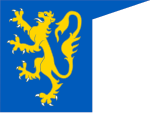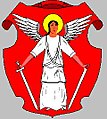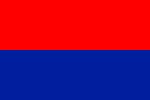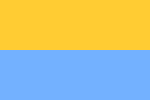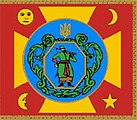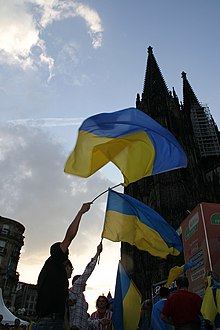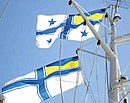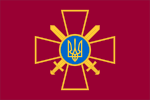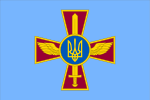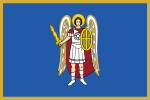Flag of Ukraine
| Flag of Ukraine | |
|---|---|
 |
|
| Vexillological symbol : |
|
| Aspect ratio: | 2: 3 |
| Officially accepted: | 4th September 1991 |
The flag of Ukraine ( Ukrainian Державний Прапор України / Derschawnyj Prapor Ukrajiny ) is the official national flag of Ukraine .
Description and meaning
The national flag of Ukraine consists of two horizontal stripes in blue and yellow. It has its origin in the coats of arms of the Varagian dynasty of the Rurikids , who ruled over the Kievan Rus and the later Russian Empire from the 9th to the 16th century .
Colours
According to popular interpretation, the colors in the flags symbolize a typical landscape of the granary of Europe, the yellow in the lower part of the flag stands for the ripe cornfields and the blue in the upper part of the flag for the sky above.
| Scheme | Azure blue | gold |
|---|---|---|
| Pantone | Pantone Coated 2935 C | Pantone Coated Yellow 012 C |
| RAL | 5019 Capri blue | 1023 Traffic yellow |
| RGB | 0, 91, 187 | 255, 213, 0 |
| CMYK | 100, 47, 0, 0 | 0, 4, 100, 0 |
| HEX | # 0057b8 | # ffd700 |
| Web safe | # 0066cc | # ffcc00 |
history
Origins of the national colors
Although the Ukraine was not established as a nation state until the 20th century, its national blue-yellow color combination is one of the oldest in Europe. The origins of the Ukrainian national colors lie in the medieval Principality of Galicia-Volhynia , where they can be found in the principality's coat of arms - a golden lion in a blue field - from the second half of the 13th century.
The first known image of the lion is assigned to the seal in a document from Prince Andreas ( Andrij ) and Leo II ( Lev II ) from 1316, some historians also refer this seal to Leo I, the son of King Daniel Romanovich von Galicia (Danylo Halyzkyj), back. The lion as the coat of arms of Ruthenia also appears on the seals of the later princes in the 14th century and, after the fall of the principality, on those of the Polish kings and Lithuanian grand princes, who divided up the territories of Galicia-Volhynia . The lion was also depicted on coins that were minted with the inscription "moneta Rutheniae" in Lemberg from 1350-1410 .
In 1410 volunteer associations from the Lviv region ( Lwiwska semla , pl. Ziemia lwówska ) took part in the battle of Tannenberg under the blue banner with the golden lion climbing on the rock at the side of the Polish king . The same colors were worn by the volunteers from the Przemyśler Land ( Peremyslanska zemla , pl. Ziemia przemyska ) - the blue banner with the golden double-headed eagle.
 ? Banner of Halych-Volhynia
? Banner of Halych-Volhynia
 ? Banner of the Lviv Land at the Battle of Tannenberg, 1410
? Banner of the Lviv Land at the Battle of Tannenberg, 1410
 ? Banner of the Przemysler Land at the Battle of Tannenberg 1410
? Banner of the Przemysler Land at the Battle of Tannenberg 1410
National colors under Polish rule
Immediately after the death of the last Galician-Volhyn prince Bolesław Troidenowicz in 1340 (poisoned by boyars in Volodymyr-Wolynskyj ), the first Polish prince , King Casimir III. led by the great , conquest campaign to Galicia-Volhynia, which failed after a short time. Galicia and Volhynia were ruled by a noble oligarchy (boyars) for almost two decades until Casimir III. the Great finally incorporated it into the Polish royal crown in 1349.
In 1432 the conquered Galician lands were united in the Ruthenian Voivodeship . The golden Galician lion became the coat of arms of the voivodeship . Attempts to Polonize the heraldic animal by changing the color to red and white are also known, but the “ Ruthenian lion ” remained yellow and blue and symbolized the western Ruthenian countries until the 17th century.
Cossacks and hetmanates
In contrast to the western Ukrainian countries, there was no clear color assignment in the former eastern Ukraine. The Cossacks , who have lived here since the 15th century, usually used that which the respective monarchs presented to them during the campaigns at their side. For example, Rudolf II , Emperor of the Holy Roman Empire of the German Nation , had a banner brought to them through his envoy Erich Lasota in 1593, which the Cossacks also used in later campaigns.
During the uprising under Hetman Bohdan Khmelnyzkyj 1648-1654, the Cossacks carried banners in various colors, mostly with images of the celestial bodies (stars and crescent moon) and crosses as well as the respective country coats of arms or the coat of arms of the Hetman. The most important of these, however, was the blue banner with the red and white (Polish) eagle given by the Polish King Władysław IV. Wasa in 1646 . In February 1649 the ambassadors of the newly elected Polish King John II Casimir presented the hetman with a red banner with the white eagle and the inscription "Ioannes Casimirus rex" in Perejaslaw . The two insignia were lost in the battle of Berestetschko in 1651 .
The Zaporozhian Cossacks had their own flags. The large banner of the Zaporozhian Sitsch ( Zaporischska Sitsch ) was red with the white image of the Archangel Michael (coat of arms of the Ruthenian countries in the Grand Duchy of Lithuania , now also the city coat of arms of Kiev ) on the front and the white orthodox cross surrounded by golden celestial bodies - sun, stars , Crescent moon - at the back. The individual units had their own banners, mostly in dark red and with portraits of saints or orthodox crosses, which at the end of the 19th century led to the erroneous assumption that all Cossack banners were dark red. At sea, the Cossacks used a white banner with the image of St. Nicholas .
Since the 18th century, the blue-yellow color combination has also started to spread in the Hetmanat ( Heťmanschtschyna ). The legend that this cannot be traced back to western Ukrainian influences (western Ukraine was in Polish hands at that time) but rather to the flag of Sweden has not been confirmed . During the Great Northern War , the Ukrainian hetman Iwan Masepa ran to the Swedish king Karl XII. about, with whom he later the decisive Battle of Poltava against Peter I lost. The Swedish loyal Cossacks wore blue and yellow armbands during this time in order to be recognized by the Swedes as allies.
At that time a Cossack with the shouldered musket, which was also understood as the coat of arms of the nation , in combination with the emblem of a regiment or a hundred, usually appears on banners . The colors were gold on blue. A well-known such banner is for example that of the Domontiv Hundred of the Perejasław Regiment from 1762. There is also contemporary evidence that the Ukrainian Hajdamaks wore blue and yellow clothes during the uprising under Ivan Gonta in 1768.
Coat of arms of the Principality of Kiev with the Archangel Michael
Archangel Michael in the coat of arms of the Kiev Voivodeship , 1569–1793
Galicia and Lodomeria

As a result of the first partition of Poland in 1772, the Ruthenian Voivodeship passed to Austria , which claimed the area due to a brief sovereignty of the Kingdom of Hungary over the Principality of Galicia-Volhynia . Since then, the countries concerned have also been an integral part of the Hungarian royal statute, which the Habsburgs now led. The new Latinized name for the affiliated countries was derived from this title - Kingdom of Galicia and Lodomeria .
After the annexation to Austria , the old national colors blue and yellow were forgotten. The kingdom was given a new coat of arms - raven on a red bar with three gold crowns - and new national colors. Initially red-yellow-blue, then until the formation of the Duchy of Bukowina in 1849 only the coat of arms colors blue-red. After Bucovina was hived off, blue on red was set for the same, while red on blue was set for Galicia and Lodomeria as the national flag.
There was a renaissance of the Ruthenian national colors only during the revolutionary turnaround in 1848. On May 2nd, the Ruthenian Main Council ( Holowna Ruska Rada ) was constituted in Lemberg , and it took a pro-Austrian position. When the blue and yellow flag appeared on the Lviv town hall in June , the council members immediately distanced themselves from it.
In April 1848 the Austrians allowed the establishment of a national guard "in support of order". In Art. 19 of the statutes it was noted “every battalion should have a banner, every squadron a standard in national colors” . During the first Pan-Slavic Congress in Prague (June 2-16, 1848), the Ruthenian and Polish delegations reached a compromise, according to which the units of the National Guard in Galicia should use the coats of arms and colors of both peoples.
In fact, however, a Polish guard was formed, whereupon the Ruthenian side declined to participate. On September 20, 1848, the main Ruthenian Council called for the establishment of a Ruthenian National Guard. Their units used the golden "Ruthenian lion" in blue as a badge. Because of the technically demanding production of the banners with the illustration of the golden lion, the simple flags with two horizontal stripes in the "Ruthenian colors" with the combination of blue-yellow or yellow-blue were gradually used.
Since Galicia had become a kind of “Ukrainian Piedmont ” at the end of the 19th century , the reborn national colors were quickly adopted throughout Ukraine (most of it was in the then Russian Empire ). When there was a broad discussion about the national symbols in Lviv and Kiev magazines from 1911 to 1913 , the colors were out of the question, the only disputes being about their arrangement - yellow-blue or blue-yellow.
 ? National flag of Galicia and Lodomeria , 1772
? National flag of Galicia and Lodomeria , 1772
 ? National flag of Galicia and Lodomeria , approx. 1800–1849 National
? National flag of Galicia and Lodomeria , approx. 1800–1849 National
flag of Bucovina , 1849–1918 ? National flag of Galicia and Lodomeria , 1849–1918
? National flag of Galicia and Lodomeria , 1849–1918
 ? Banner of the Ruthenian National Guard, 1848
? Banner of the Ruthenian National Guard, 1848
The Ukrainian People's Republic
After the outbreak of the February Revolution in Russia in 1917 and the abdication of the Tsar, the Ukrainian Central Council ( Ukrajinśka Zentralna Rada ) was formed in Kiev as the provisional political representation of the Ukrainian nation. The first intention of the Rada was to create a Ukrainian autonomy within the newly proclaimed Russian Federation . After the overthrow of the provisional government under Kerensky in St. Petersburg on November 7, 1917 by the Bolsheviks (so-called October Revolution ), the Rada in Kiev distanced itself and finally proclaimed the Ukrainian People's Republic ( Ukrajinśka Narodnia Respublika ) on November 22, but this did so initially while maintaining a federal connection with the "democratic Russian republic" (Soviet Russia did not recognize the Rada as such). The declaration of complete independence from Russia followed on January 24, 1918.
At this point the question of the national colors of the Ukrainians had already been largely resolved. The blue-yellow color combination originally from Galicia was recognized as the national flag in both parts of the country (formerly Russian and Austrian) . The first legal regulation of the national colors by the Zentralna Rada took place on January 14, 1918 in the Provisional Law on the Fleet of the Ukrainian People's Republic. Art. 2 of the law stipulated : “Flag of the Ukr. Navy is a banner in two colors: blue and yellow. In the blue part there is the historical golden trident with a white inner field. ” Article 3 stipulates: “ The flag of the Ukrainian merchant fleet is a banner in two colors: blue and yellow. ”
Ukraine's first democratic government did not last long. On April 29, 1918, when the Centralna Rada was just passing a provisional constitution for the Ukrainian People's Republic , a coup took place under the German-supported Tsarist General Pavlo Skoropadskyj .
 ? Flag of the Ukrainian navy from January 14, 1918
? Flag of the Ukrainian navy from January 14, 1918
 ? Flag of the Ukrainian merchant fleet from January 14, 1918
? Flag of the Ukrainian merchant fleet from January 14, 1918
The Ukrainian state under Hetman Skoropadski
On April 29, 1918, General Skoropadskyj, supported by the Germans, seized power and was proclaimed hetman of the Ukrainian state , which was to replace the Ukrainian People's Republic , which was dominated by social democracy . Skoropadskyj was the offspring of an old Ukrainian Cossack family, direct successor to Wasyl Skoropadskyjs, the brother of Hetman Ivan Skoropadskyj (Hetman of the Left Banks of Ukraine 1709–1722).
He understood the Ukrainian state as a continuation of the old hetmanate from the 18th century with a quasi-monarchical head of state, the hetman, which should also be reflected in the state symbols. However, he could not do without the symbols of the People's Republic entirely. State seal and coat of arms now showed the Cossack with shouldered musket in combination with the Trysub (trident) of the republic. The order of the colors in the flag was changed again and the blue and yellow flag was declared the flag of the Ukrainian state. Tryzub and blue-yellow colors also became part of the military uniform under Hetman.
A number of service flags with the national symbols were also developed. On July 18, 1918, the hetman set the service flag of the Ukrainian state fleet. The flag was based on the war flag of the German Imperial Navy and represented a dark blue cross on a white background with the national bicolor and the bronze Trysub in the upper left corner. This official flag, but without Trysub, is today used again by the Ukrainian Navy as Service flag used.
 ? State flag of the Ukrainian State , 1918
? State flag of the Ukrainian State , 1918
 ? Imperial war flag of the German Empire, 1871–1919
? Imperial war flag of the German Empire, 1871–1919
 ? Service flag of the Ukrainian State Fleet, 1918
? Service flag of the Ukrainian State Fleet, 1918
Standard of the hetman Pavlo Skoropadskyj , 1918
Western Ukrainian People's Republic
After the dissolution of Austria-Hungary , the Ukrainian National Council , which was constituted in Lviv , declared on November 13, 1918, in the Provisional Basic Law on the state independence of the Ukrainian countries of the former Austro-Hungarian monarchy, the establishment of the West Ukrainian People's Republic in the areas of the Crown Lands of Galicia inhabited by Ukrainians / Ruthenians and Bukovina and the Kingdom of Hungary . The state symbols of the new republic were also established in the same law.
Flag of the Ukrainian SSR
In 1919 the Ukrainian Soviet Socialist Republic (Union republic since 1922, founding member of the Soviet Union ) was founded. It received the red flag of the communist movement with the abbreviation “УССР” (USSR, Ukrayinskaya sotsialisticheskaya Sovetskaya Respublika in Russian ) in the upper leech , in 1923 dots were added after the letters. In 1927 the abbreviation was changed to “YCPP” (USRR). In the 1930s, the dots were removed again and the abbreviation was placed in a box with a thin, golden line. The box disappeared again in 1937 and the abbreviation was translated into Ukrainian . The hammer and sickle appeared above "У.Р.С.Р." (URSR, Ukrajinska Radjanska Sozialistytschna Respublika) . In the 1940s the dots disappeared again and the hammer and sickle went under the letters. After the Second World War , in 1949 the Soviet republics received new flags as recognition, which also took regional characteristics into account. The new flag of the Ukrainian SSR was adopted by the Soviet Union, but received a blue stripe below a combination of hammer and sickle with the red star . The Ukraine kept this flag from November 25, 1949 to August 24, 1991. All flags during the Soviet era were missing the gold-colored elements on the back.
Return of the blue and yellow national flag
Under the influence of Gorbachev's perestroika and glasnost , efforts towards greater national autonomy and even full detachment from the Soviet Union intensified in the individual Soviet republics towards the end of the 1980s . This particularly affected the Baltic republics and western Ukraine , areas that were the latest to become part of the USSR . These efforts went hand in hand with attempts to restore the respective historical national symbols. Processions, demonstrations and popular festivals under the national blue and yellow flags of the Ukrainian and Western Ukrainian People's Republics, which were briefly independent from 1917 to 1920, became more and more frequent, especially in western Ukraine and Kiev .
- On March 20, 1990, the city council ( miśka rada ) in Ternopil, Galicia , decided to reintroduce the national blue and yellow flag and the Trysub (trident) as well as the national anthem Shche ne wmerla Ukrajiny . On the same day, the blue and yellow national flag was hoisted on the Rada building and thus on the first government building in Ukraine next to the then official red and blue flag of the Ukrainian SSR.
- On April 28, 1990, the decision of the Oblastna rada of the Lviv Oblast to use the national symbols of Ukraine in the Lviv Oblast followed.
- On April 29, 1990, after a solemn consecration, the blue and yellow national flag was hoisted for the first time without the official flag of the USSR on the square in front of the city theater in Ternopil.
- After the declaration of state independence of the Ukrainian SSR by the Supreme Soviet of the Ukrainian SSR on July 16, 1990, the national flag was ceremoniously hoisted next to the state flag of the USSR on the building of the Kiev City Council on Khreshchatyk on July 24, 1990 at 7 p.m. Thus, for the first time since the fall of the Ukrainian People's Republic, the national blue and yellow flag waved over an official building in the Ukrainian capital.
- After the declaration of independence from the Soviet Union on August 24, 1991, the national flag of Ukraine flied over the Ukrainian parliament for the first time .
More flags of Ukraine
State flags
Both the various armed forces of Ukraine and the president have their own flags. The Navy service flag, introduced in 1997, was slightly modified in 2006.
2: 3 ? Service flag of the Navy , 1997 to 2006


2: 3 ? Service flag of the Navy, since 2006

Service flag and a command flag
Regional flags
As an autonomous republic, the Crimea flies its own flag. Likewise, the oblasts , rajons and municipalities each have their own flags.
Rajon velyka novosilka
Individual evidence
- ↑ W. Svirko, A. Rubcov, A. Gorpinchenko, W. Sinel'nikova, G. Docenko, O. Kupko, I. Potapenko, E. Ershova: State Flag of Ukraine. DSTU 4512: 2006 . State Standards of Ukraine, Kiev September 2006, p. 7.
literature
- Andrij Grečyło: Do pytannia pro nacionalnyj prapor. ( Memento from February 28, 2006 in the Internet Archive ) In: Pamjatky Ukrajiny. 1989, No. 4, pp. 44-48. (ukr.)
- Chronology of Ukrainian History in the 20th Century Kiev University History Faculty (ukr.)
Web links
- Flags of the World - Ukraine (English)


